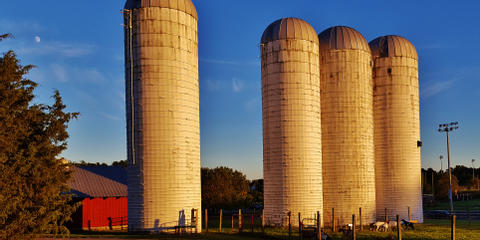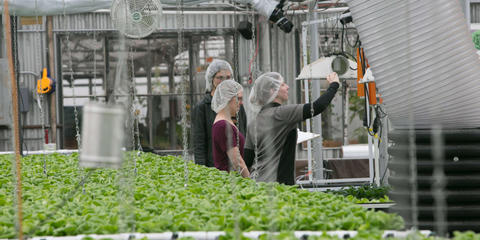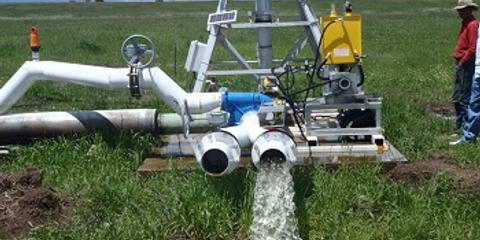Federal funding programs are under review as of 1/27/25. We'll make updates as new info is released.
NAP provides financial assistance to producers of noninsurable crops when low yields, loss of inventory, or prevented planting occur due to natural disasters.
Eligibility
Eligible Producers
Eligible crops include those for which federal crop insurance is not available, such as fruits, vegetables, aquaculture, floriculture, mushrooms, turfgrass, ginseng, honey, maple sap, and others. Producers must meet specific criteria and comply with all program requirements. Producers are encouraged to check with their local FSA office for specific requirements, application deadlines, and additional program details.
An eligible producer is a landowner, tenant or sharecropper who shares in the risk of producing an eligible crop and is entitled to an ownership share of that crop. An individual’s or entity’s average adjusted gross income (AGI) cannot exceed $900,000 to be eligible for NAP payments. Also, NAP payments received, directly or indirectly, will be attributed to the applicable individual or entity and limited to $125,000 per crop year, per individual or entity for crops with basic (catastrophic) coverage. Any NAP payments received directly or indirectly for crops with additional (buy-up) coverage, will be attributed to the applicable individual or entity and limited to $300,000 per crop year, per individual or entity. (To learn more, visit fsa.usda.gov/limits.)
Eligible Crops must be commercially produced agricultural commodities for which crop insurance is not available and be any of the following:
-
Crops grown for food
-
Crops planted and grown for livestock consumption, such as grain and forage crops, including native forage; Crops grown for fiber, such as cotton and flax (except trees)
-
Crops grown in a controlled environment, such as mushrooms and floriculture
-
Specialty crops, such as honey and maple sap
-
Sea oats and sea grass
-
Sweet sorghum and biomass sorghum
-
Industrial crops, including crops used in manufacturing or grown as a feedstock for renewable biofuel, renewable electricity or biobased products
-
Value loss crops, such as aquaculture, Christmas trees, ginseng, ornamental nursery and turf-grass sod
-
Seed crops where the propagation stock is produced for sale as seed stock for other eligible NAP crop production
Eligible Causes of Loss
Eligible causes of loss include the following natural disasters:
-
Damaging weather, such as drought, freeze, hail, excessive moisture, excessive wind or hurricanes
-
Adverse natural occurrences, such as earthquake or flood
-
Conditions related to damaging weather or adverse natural occurrences, such as excessive heat, plant disease, volcanic smog (VOG) or insect infestation.
The damaging weather or adverse natural occurrence must occur during the coverage period, before or during harvest, and must directly affect the eligible crop.
Terms
How It Works
Program Features
Coverage Levels
-
Catastrophic Coverage (CAT): Provides coverage at 50% of the approved yield and 55% of the average market price.
-
Buy-Up Coverage: Offers higher levels of coverage, up to 65% of the approved yield and 100% of the average market price.
Application Deadline: Producers must apply for coverage by the crop-specific application closing date.
Service Fee: Producers must pay a service fee of $325 per crop per county, not to exceed $825 per producer per county or $1,950 for multi-county producers.
Premiums: For buy-up coverage, additional premiums apply based on the coverage level selected.
Application Instructions
Applying for Coverage
Eligible producers must apply for coverage using form CCC-471, “Application for Coverage,” and pay the applicable service fee at the FSA office where their farm records are maintained. The application and service fee must be filed by the application closing date.
Application closing dates vary by crop and are established by the FSA State Committee. Contact your local FSA office to verify application closing dates. Producers who apply for NAP coverage acknowledge that they have received the NAP Basic Provisions, available at FSA county offices and at fsa.usda.gov/nap.
Resources
Related Programs

Farm Storage Facility Loan Program (FSFL)
Farm Service Agency
- Loan
- Infrastructure
- Equipment
- Storage
- Lighting
- Delivery Vehicle
- National
- Oilseeds
- Peanuts
- Pulse Crops
- Hay
- Honey
- Biomass
- Fruits
- Vegetables
- Floriculture
- Hops
- Maple Sap
- Milk
- Cheese
- Yogurt
- Butter
- Eggs
- Rye
- Aquaculture
- Poultry
- Livestock
- Grains

A Climate-Smart Strategy for the Michigan Foodshed
Star of the West Milling Company, U.S. Department of Agriculture
- Grant
- Climate-Smart
- Beginning Farmers
- Women
- MI
- Wheat
- Dried Beans
- Soybeans

ACRE3 Agricultural Energy Efficiency
Colorado Department of Agriculture
- Grant
- Cost Share
- Loan
- Alternative Energy
- Conservation
- Irrigation
- Storage
- Greenhouse
- CO
- Any

ACRE3 Irrigation Hydropower Programs
Colorado Department of Agriculture
- Grant
- Cost Share
- Loan
- Hydro Power
- Alternative Energy
- Irrigation
- Conservation
- Water Management
- Equipment
- CO
- Any
Details
Organization
Financial Instrument
Insurance
Updated December 17, 2025
Image Credit: Joshua Hoehne
This information was gathered from public sources. Ambrook is not responsible for or able to affect the results of any financial programs listed, nor are they responsible for any incorrect information that is listed or is on the hyperlinked external sites. All information is subject to change.
Explore hundreds more programs on Ambrook.
